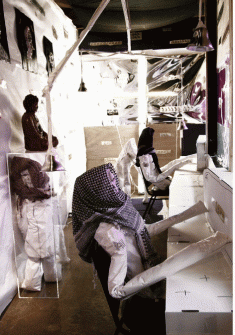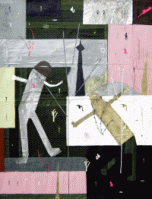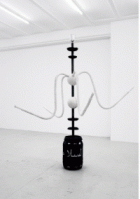Tjorg Douglas Beer
Salonu Istambul/Observation Deck
Produzentengalerie Hamburg
While Tjorg Douglas Beer’s works previously collaged disparate iconography, confuting the viewer with abstracted associations of power versus the everyday, in the Salonu there is a distinct predominance of Islamic characters and militaristic residue. Of course, the artist might contend that as his studio was located in a Muslim region of Hamburg, Shemaghs and Hijabs (head scarves) are fashion and religion alike. And there is an interesting sensitivity in this; that in order for iconography to denude itself, to exist in its most malleable state, it must shift in context to cultural characteristics.
 Hell-Net (2007-2008)
Hell-Net (2007-2008)
In the miasma of blurred cultural boundaries, reflections upon the broad nation of Islam have become taboo. For an artist, who has developed a visual language of mixed signifiers, to reflect upon this is no easy task. But Beer jumps in head first with the largest collage, wall-hanging, Pasaji Cicek (2008), where a woman in a park pushes a pram passed a flower-passage that more closely resembles a prison or barbed war-zone. A destitute man lying behind an oil drum resembles a corpse in a casket. Three Imams look on. The ordinary or the extraordinary?
Like many artists today, Beer marries the installation piece with the individual works in a provocative confluence of meanings. Hell-Net, the first of this series was installed at Henry Street Settlement, New York; while in Hamburg only its documentation was included. Still it clearly remained tethered to the Salonu at Produzentengalerie, simultaneously as its cause and effect. Its space-age dummies, who look out upon the street, man a workstation teeming with a perverse collection of contrary objects and images. While a sculptural piece unto itself, like a Duchampian diorama, it opens up new possible readings for the ‘portraits’ and ‘tapestries’ in the third part of the series, Salonu, making of them artefacts in one instant and screens for the present in the next. Further still, works like Eden/Danse (2008), a wall-hanging layering hijabs, foil and plastic, illustrate what the artist refers to as ‘heterodyne levels of meaning’, where mixing two frequencies creates two new frequencies, one at the sum of the two mixed, and the other at their difference. In these works, barbed wire also resembles foliage, nuclear fission resembles flowers, and a silhouette of a man praying resembles a man cowering beneath a gun or machete.
 Eden/Danse (2007)
Eden/Danse (2007)
 Salaam Aleikum (2008)
Salaam Aleikum (2008)
But as in all of Beer’s oeuvre, the graphic, caricature-like representation brings a comic aspect to any possible meaning. Almost like an aside, the work winks at you, saying, I am not an altarpiece; I am just graffiti. And then winks at you again, I am not graffiti… It is best illustrated by an enormous, communal hookah in the gallery centre, where what is smoked must be filtered through its macabre base, while its cartoon-ish hoses extend outward.
With Tjorg Douglas Beer, we gather the sense of irony; we feel the humour, but with it a strange creeping feeling, a kind of impending doom, where the artist is saying more than he is saying, and should you agree with what you know, you may become an accomplice to what you do not.